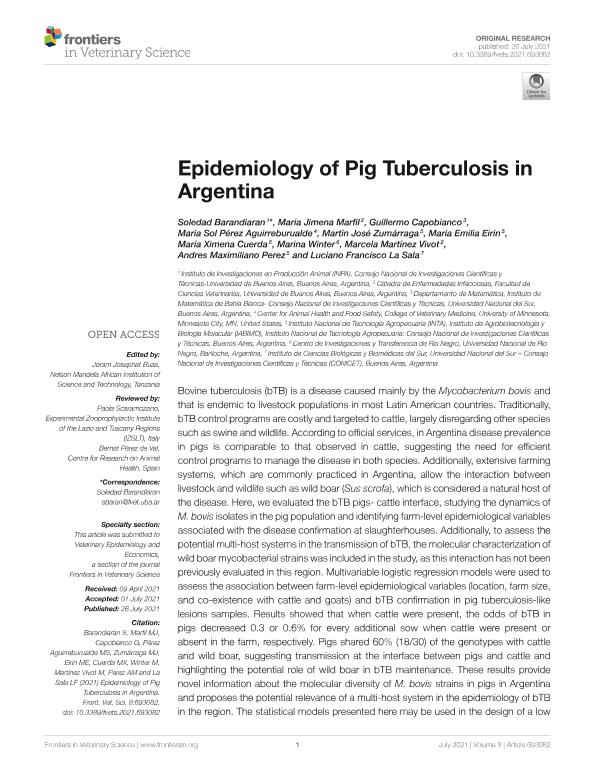Artículo
Epidemiology of Pig Tuberculosis in Argentina
Barandiaran, Soledad ; Marfil, Maria Jimena
; Marfil, Maria Jimena ; Capobianco, Guillermo
; Capobianco, Guillermo ; Pérez Aguirreburualde, María Sol
; Pérez Aguirreburualde, María Sol ; Zumárraga, Martín José
; Zumárraga, Martín José ; Eirin, María Emilia; Cuerda, María Ximena; Winter, Marina
; Eirin, María Emilia; Cuerda, María Ximena; Winter, Marina ; Martínez Vivot, Marcela; Perez, Andres Maximiliano
; Martínez Vivot, Marcela; Perez, Andres Maximiliano ; la Sala, Luciano Francisco
; la Sala, Luciano Francisco
 ; Marfil, Maria Jimena
; Marfil, Maria Jimena ; Capobianco, Guillermo
; Capobianco, Guillermo ; Pérez Aguirreburualde, María Sol
; Pérez Aguirreburualde, María Sol ; Zumárraga, Martín José
; Zumárraga, Martín José ; Eirin, María Emilia; Cuerda, María Ximena; Winter, Marina
; Eirin, María Emilia; Cuerda, María Ximena; Winter, Marina ; Martínez Vivot, Marcela; Perez, Andres Maximiliano
; Martínez Vivot, Marcela; Perez, Andres Maximiliano ; la Sala, Luciano Francisco
; la Sala, Luciano Francisco
Fecha de publicación:
07/2021
Editorial:
Frontiers Media
Revista:
Frontiers in Veterinary Science
ISSN:
2297-1769
Idioma:
Inglés
Tipo de recurso:
Artículo publicado
Clasificación temática:
Resumen
Bovine tuberculosis (bTB) is a disease caused mainly by the Mycobacterium bovis and that is endemic to livestock populations in most Latin American countries. Traditionally, bTB control programs are costly and targeted to cattle, largely disregarding other species such as swine and wildlife. According to official services, in Argentina disease prevalence in pigs is comparable to that observed in cattle, suggesting the need for efficient control programs to manage the disease in both species. Additionally, extensive farming systems, which are commonly practiced in Argentina, allow the interaction between livestock and wildlife such as wild boar (Sus scrofa), which is considered a natural host of the disease. Here, we evaluated the bTB pigs- cattle interface, studying the dynamics of M. bovis isolates in the pig population and identifying farm-level epidemiological variables associated with the disease confirmation at slaughterhouses. Additionally, to assess the potential multi-host systems in the transmission of bTB, the molecular characterization of wild boar mycobacterial strains was included in the study, as this interaction has not been previously evaluated in this region. Multivariable logistic regression models were used to assess the association between farm-level epidemiological variables (location, farm size, and co-existence with cattle and goats) and bTB confirmation in pig tuberculosis-like lesions samples. Results showed that when cattle were present, the odds of bTB in pigs decreased 0.3 or 0.6% for every additional sow when cattle were present or absent in the farm, respectively. Pigs shared 60% (18/30) of the genotypes with cattle and wild boar, suggesting transmission at the interface between pigs and cattle and highlighting the potential role of wild boar in bTB maintenance. These results provide novel information about the molecular diversity of M. bovis strains in pigs in Argentina and proposes the potential relevance of a multi-host system in the epidemiology of bTB in the region. The statistical models presented here may be used in the design of a low cost, abattoir-based surveillance program for bTB in the pig industry in Argentina, with potential extension to other settings with similar epidemiological conditions.
Archivos asociados
Licencia
Identificadores
Colecciones
Articulos(SEDE CENTRAL)
Articulos de SEDE CENTRAL
Articulos de SEDE CENTRAL
Citación
Barandiaran, Soledad; Marfil, Maria Jimena; Capobianco, Guillermo; Pérez Aguirreburualde, María Sol; Zumárraga, Martín José; et al.; Epidemiology of Pig Tuberculosis in Argentina; Frontiers Media; Frontiers in Veterinary Science; 8; 693082; 7-2021; 1-8
Compartir
Altmétricas



